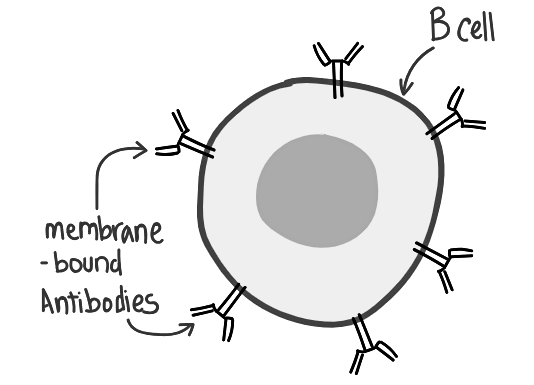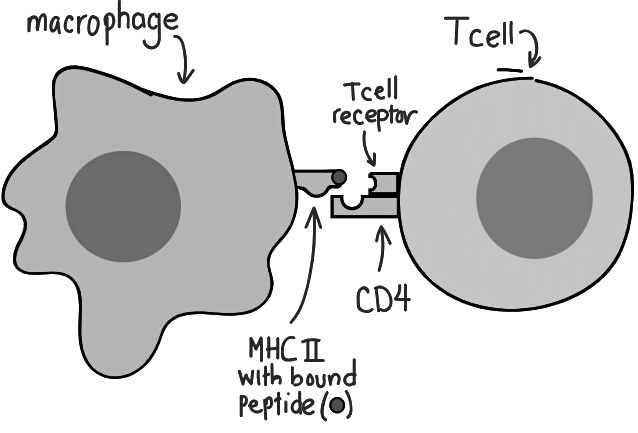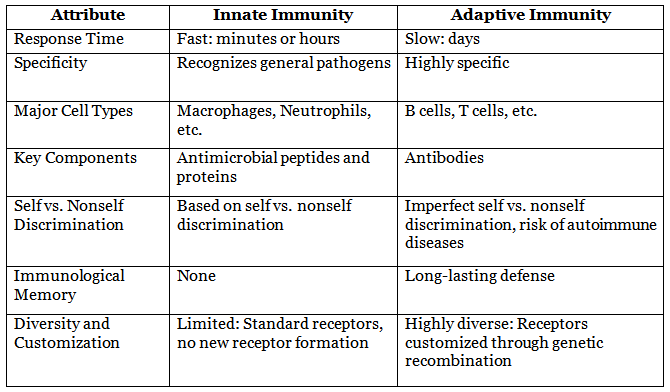MCAT Exam > MCAT Notes > Biology for MCAT > Adaptive Immunity
Adaptive Immunity | Biology for MCAT PDF Download
| Table of contents |

|
| Introduction |

|
| The Role of Adaptive Immunity |

|
| B Cells: The Antibody Producers |

|
| T Cells: Orchestrators of the Immune Response |

|
| Types of Mature T Cells |

|
| Breakdowns in Immunological Memory |

|
Introduction
Have you ever noticed that your recovery time from common colds, flu, or small infections seems to decrease after the first successful recovery? This phenomenon is attributed to the adaptive immune system, also known as acquired immunity. Unlike the innate immune system, which responds to general threats, the adaptive immune system utilizes specific antigens to strategically mount a targeted immune response. This article delves into the workings of adaptive immunity, highlighting its unique features and the role it plays in safeguarding our health.
The Role of Adaptive Immunity
Adaptive immunity is activated when the body is exposed to pathogens, enabling it to learn about the threat and enhance the immune response through immunological memory. While the innate immune response is immediate, the adaptive immune response is slower as it requires time to recognize and respond to specific threats and infections. It accomplishes this through the actions of specialized cells, namely B cells and T cells.
Cells of the Adaptive Immune System
Unlike the innate immune system, the adaptive immune system relies on two main types of cells: B cells and T cells. Both B cells and T cells are lymphocytes derived from multipotent hematopoietic stem cells in the bone marrow. These cells undergo maturation and activation processes, ultimately assuming their distinct forms and functions.
B Cells: The Antibody Producers
- After maturation in the bone marrow, B cells migrate to the lymphatic system to circulate throughout the body. Naive B cells possess millions of distinctive surface antigen-specific receptors encoded in their DNA. These receptors, known as antibodies or membrane-bound antibodies, enable B cells to recognize specific antigens. When a naive B cell encounters an antigen that matches its receptor, it undergoes division to become either a memory B cell or an effector B cell, also known as a plasma cell.
- Memory B cells retain the same receptor as the parent B cell, while plasma B cells produce antibodies without being membrane-bound. These secreted antibodies identify free pathogens in the body. Therefore, when a naive B cell divides and differentiates, both plasma cells and memory B cells are generated. B cells also express a specialized receptor called the B cell receptor (BCR), which aids in antigen binding, internalization, and processing. Moreover, BCRs play a crucial role in signaling pathways that facilitate communication with other immune cells.

T Cells: Orchestrators of the Immune Response
- Similarly, T cells undergo maturation in the thymus after formation in the bone marrow. Developing T cells express T cell receptors (TCRs), as well as CD4 and CD8 receptors. T cell receptors recognize antigens presented on major histocompatibility complex (MHC) molecules. CD4 and CD8 receptors assist in T cell recognition and activation by binding to MHC class I (MHCI) or class II (MHCII) molecules.
- To ensure the proper functioning of mature T cells, they undergo two selection processes: positive selection and negative selection. Positive selection tests the ability of T cells to bind only self-MHC molecules, ensuring MHC restriction. Cells that fail this selection process are eliminated. Negative selection, on the other hand, tests for self tolerance. T cells should bind to self-MHC molecules presenting foreign antigens, while avoiding self-MHC molecules presenting self-antigens. T cells that fail negative selection are eliminated to prevent autoimmune diseases.

Types of Mature T Cells
Following positive and negative selection, three types of mature T cells emerge: Helper T cells (TH cells), Cytotoxic T cells (TC cells), and T regulatory cells (Treg cells). Helper T cells express CD4 and facilitate the activation of B cells, TC cells, and other immune cells. Cytotoxic T cells express CD8 and are responsible for eliminating pathogens and infected host cells. T regulatory cells also express CD4, along with CD25, and help differentiate between self and nonself molecules, reducing the risk of autoimmune diseases.
Humoral vs. Cell-Mediated Immunity
Adaptive immunity provides two types of immunity: humoral and cell-mediated immunity. Humoral immunity is mediated by B cells and antibodies, while cell-mediated immunity involves the actions of T cells. Humoral immunity can be acquired through the administration of antibodies or plasma cells from an individual who has successfully recovered from a specific disease. Cell-mediated immunity, on the other hand, can be acquired through the transfer of TH and TC cells from an immune individual. These cells activate other immune cells and eliminate pathogens and infected host cells.
Immunological Memory: Long-Lasting Defense
One of the remarkable features of adaptive immunity is its ability to learn and remember specific pathogens, resulting in long-lasting defense against recurrent infections. This immunological memory is achieved through the production of pathogen-specific antibodies. Vaccinations provide a practical example of immunological memory. By exposing the body to antigens or parts of a virus, vaccinations prompt the production of antibodies without causing active infection. As a result, the body acquires a memory of the virus, leading to a faster and more effective immune response upon subsequent exposure.
Breakdowns in Immunological Memory
While immunological memory is crucial for protection against pathogens, breakdowns in this system can lead to autoimmune diseases. Some infections, such as Streptococcus, employ molecular mimicry to evade immune defenses. This molecular mimicry can trigger an autoimmune response, as the immune system mistakenly attacks self-antigens resembling the infectious pathogen.
Innate Immunity vs. Adaptive Immunity: A Summary
To summarize the key differences between innate and adaptive immunity, refer to the table below:

Conclusion
The adaptive immune system plays a vital role in our ability to defend against infections and diseases. Through B and T cells, it orchestrates a targeted immune response, harnessing the power of immunological memory to provide long-lasting defense. Understanding the intricacies of adaptive immunity contributes to our overall knowledge of the immune system and its remarkable capacity to protect our health.
The document Adaptive Immunity | Biology for MCAT is a part of the MCAT Course Biology for MCAT.
All you need of MCAT at this link: MCAT
|
233 videos|16 docs|32 tests
|
Related Searches














